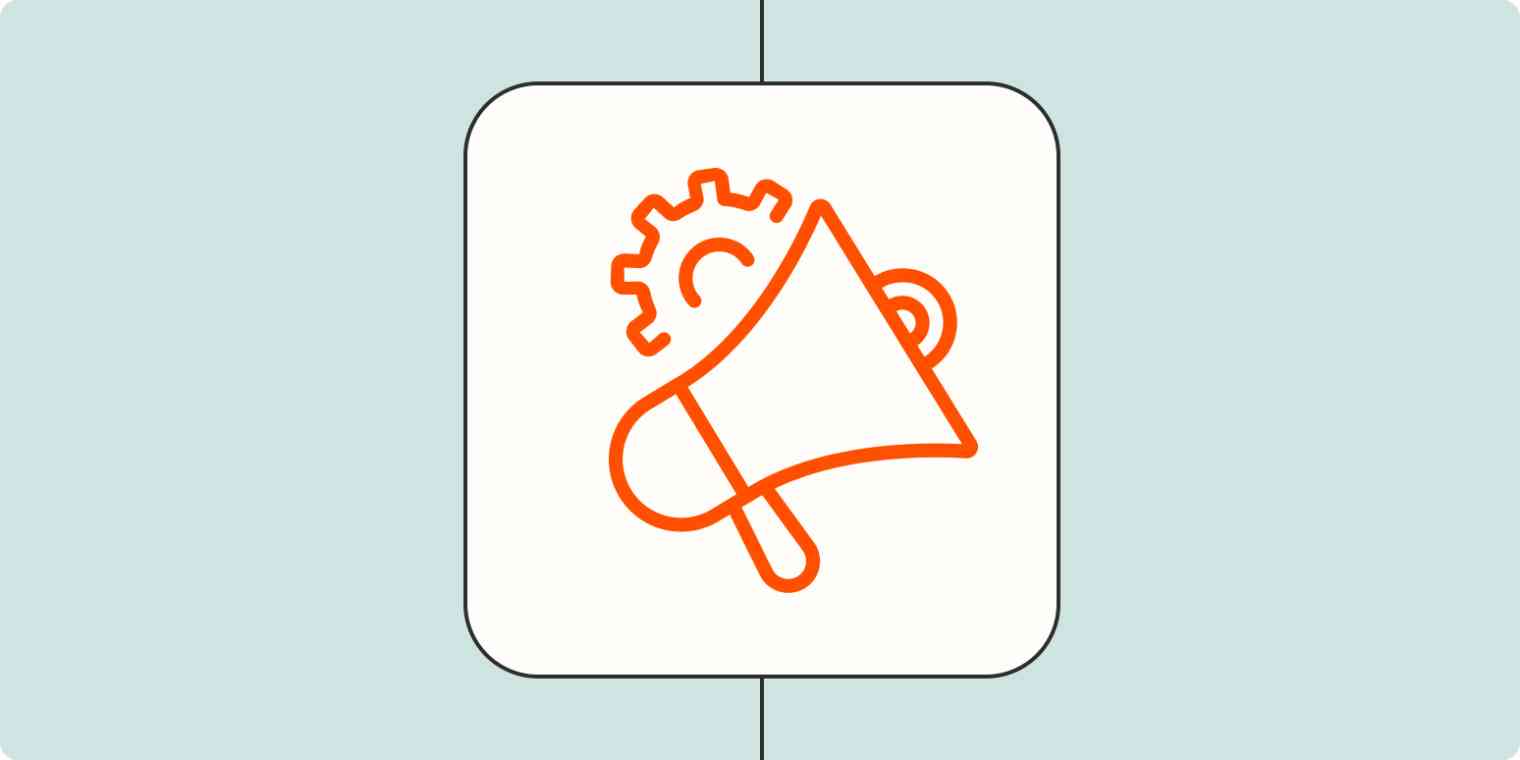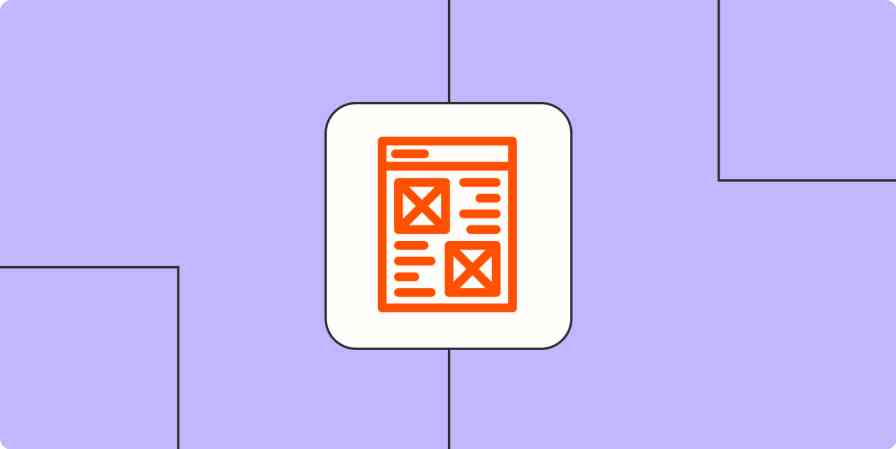Super Bowl ads, billboards, listicles, banners, influencers, door-to-door sales—these are all marketing channels, the different roads leading to your future customers. But which path should you take?
It's like deciding between taking scenic back roads or a highway on a road trip. Both have their advantages, and your choice will hinge on what you're looking to get out of the journey. If you're operating on a shoestring budget, you might lean toward affiliate marketing. But if you've got some cash to burn and want to make a big splash, securing a 30-second TV spot could be your freeway to success.
Having spent eight years in digital marketing, crafting strategies and copy for virtually every industry, I've seen firsthand the importance of picking the right channels. More accurately, I've spent a lot of money on the wrong marketing channels. Below, I'll dissect what a marketing channel actually is, walk you through 19 different channels you can use, and equip you with the know-how to pick the ones that align with your business goals while hopefully saving you from making some of the same mistakes I did when starting out.
Table of contents:
What are marketing channels?
Marketing channels are all the ways you can communicate your brand with your customers. Think of them as the roads, highways, and tiny dirt paths that link your business to Jim from Tallahassee and Emilia from Paris. They can be as modern as a targeted Instagram ad or as traditional as a billboard off Route 66.
There are four basic types of marketing channels:
Digital: These are your online touchpoints—think social media, email, and your website.
Traditional: These are the classics that never go out of style—TV, print ads, and even radio.
Direct: With direct channels, there's no intermediary. You're communicating straight to the customer, maybe through a sales call or a direct mailer.
Indirect: Indirect channels use third parties to help—think retailers or affiliate websites. Sometimes it helps to have a wingman to help spread the word.
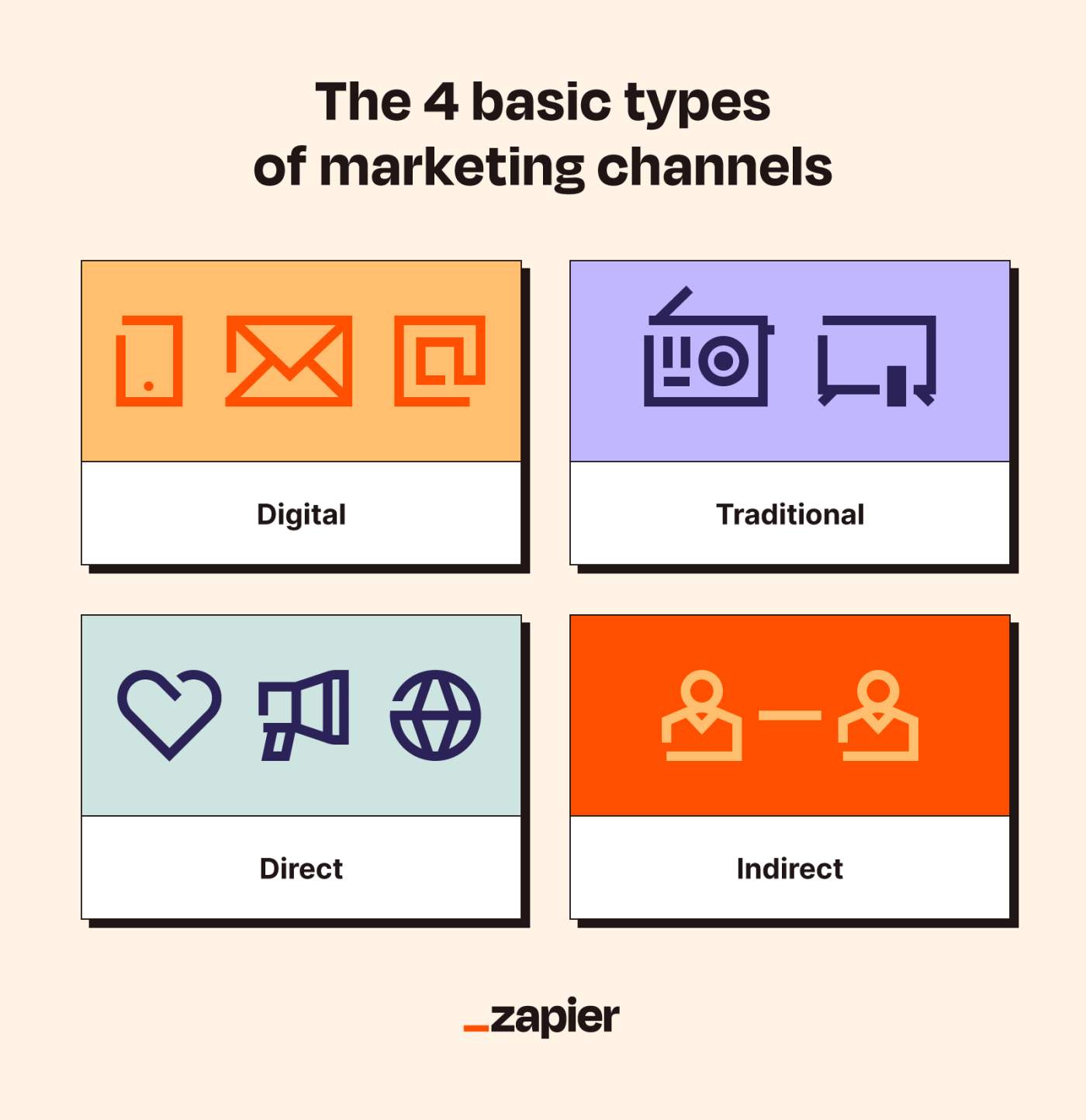
1. Website
Think of your website as your online storefront—the digital handshake that offers a first impression to visitors like Jim and Emilia. This is where you let your brand's personality shine—whether that's cheeky, corporate, or somewhere in between. From the moment they land on your homepage to when they check out, you want to make their experience as smooth as possible.
Take a look at Apple's homepage.
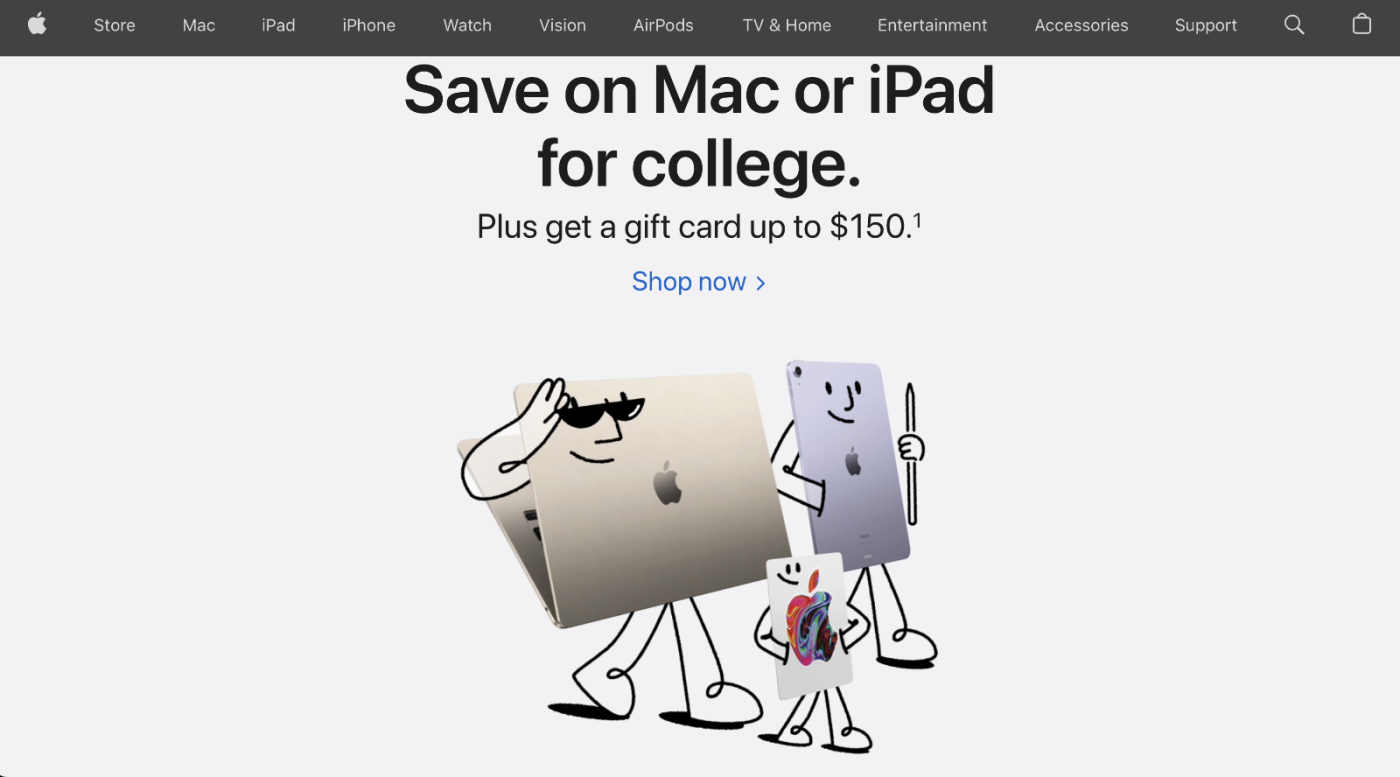
It's on-brand, includes a promotion right away, and is easy to navigate. What more could a potential customer want?
Type: Digital
When to use: Always; your website serves as your digital storefront and hub for all marketing activities.
Cost: Varies; a Shopify site can be affordable and easy to set up, while a bespoke site built from scratch and loaded with custom features can carry a high price tag.
2. Social media
Social media is the backyard barbecue of the internet, where everyone's invited and the conversations never stop. This is where you get to be not just a logo, but also a personality. It's all about engagement, connection, and those all-important likes and shares.
But it's not just about organic interactions: ads tailored to user interests and behaviors have become incredibly potent on social media. Social media ads allow brands to reach audiences beyond their followers, targeting demographics, locations, and even specific behaviors. Whether it's a sponsored post, a story ad, or an in-feed video, these advertisements are designed to be less intrusive and more in tune with the user experience.
Together, organic engagement and strategic advertising on social media offer a one-two punch for brands aiming to connect, converse, and convert.
Ryanair has a great social media presence.
Look, if it fits it flies https://t.co/AuzoN0Qlyl
— Ryanair (@Ryanair) August 16, 2023
The company engages with its customers, pokes fun at itself, and the content is outright entertaining. And as you can see, people love it. The content gets shares, and the shares get in front of the eyeballs of potential customers.
Type: Digital
When to use: Great for regular engagement, sharing memes, and quick updates.
Cost: Free to moderate; organic posts are free, but you may have to hire a social media manager as you grow; the cost of ads varies depending on the type and platform.
3. Blog SEO
So you've got a website. Great! But SEO-optimized blog content is the long game that turns your site from an online brochure into a dynamic platform that reels in the customers. Your content isn't just a "nice-to-have"—it's your brand's opportunity to show off its expertise, answer burning questions, climb up Google's ranks, and drive qualified traffic to your product.
NerdWallet is a fantastic example of SEO done well.
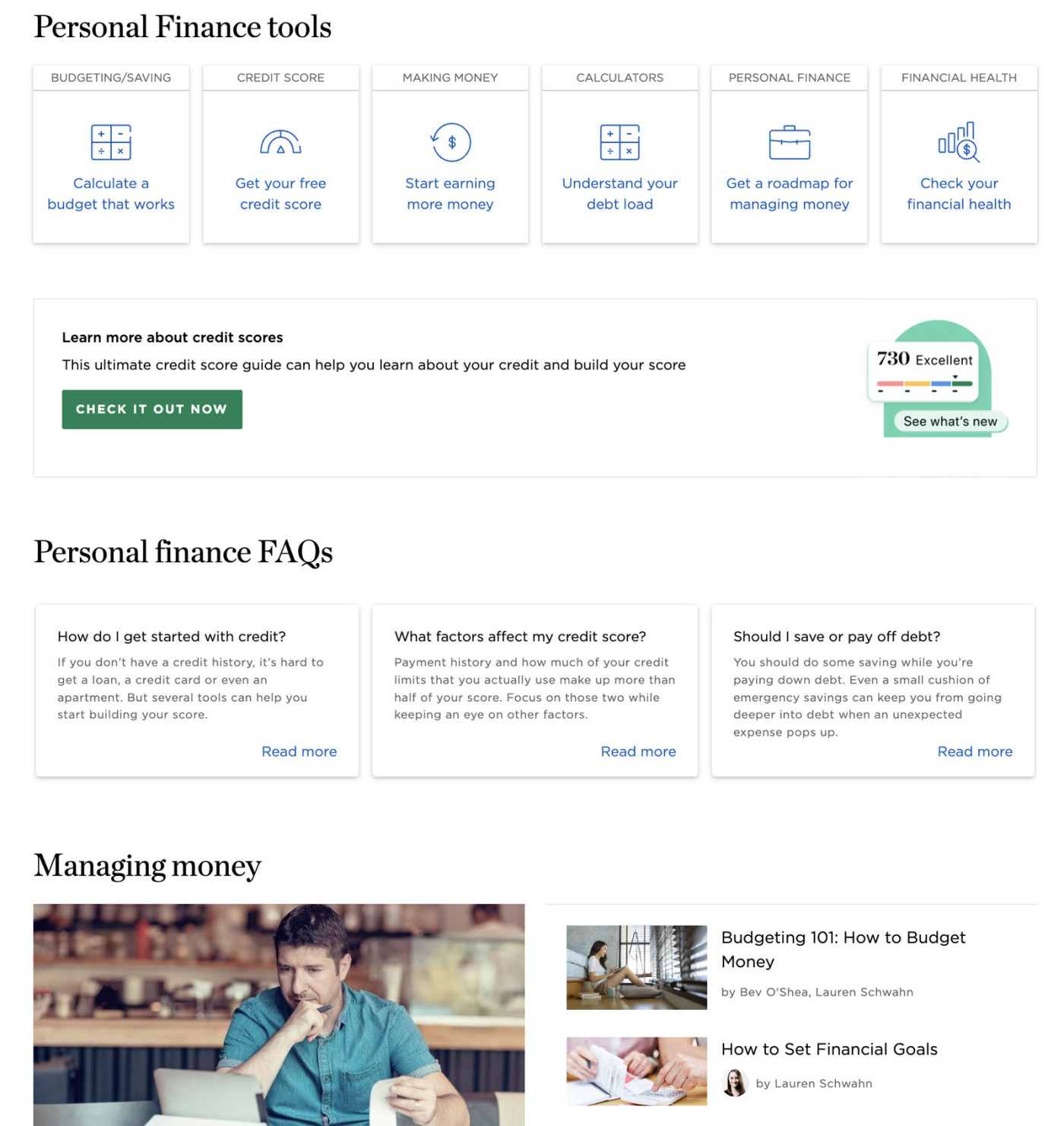
NerdWallet's layout is intuitive, there are a lot of shareable resources, and its content focuses on exactly what visitors are looking for. Anytime you search something about personal finance, you're bound to get a NerdWallet result—that's impressive SEO.
Type: Digital
When to use: If you want to be known as an authority in your industry and increase traffic to your domain, turn to SEO-focused blogging.
Cost: Varies; in-house writing from your existing team can be low-cost, but outsourcing to experts like consultants or agencies that handle end-to-end SEO strategy and content production can be really expensive.
4. Podcasts
Your blog is your brand in text; a podcast is your brand in voice. Whether you're discussing industry trends, telling brand stories, or interviewing experts, this is your space to really engage with your customers. Podcasts let your brand sit back and talk with your audience—literally. It's where you can hash out ideas and tell tales that are too good to abbreviate.
Duolingo has absolutely crushed its foray into podcasting.

These podcasts share real stories from real people in an easy-to-understand mix of English and French or Spanish. They're engaging, helpful, and stay true to the brand's product.
Type: Digital
When to use: Podcasts are a great way to showcase your brand and your personality while establishing your expertise; they're also a nice first step into owned media.
Cost: Moderate; costs include equipment, hosting, and possibly editing services. It'll depend how low-fi you're willing to go.
Read about how one podcast thrives on automation.
5. Digital ads
Digital ads are the banners and display ads that paint the white spaces of the internet. And it's a competitive game. You can't just blend into the background; you need to jump off the screen. But it's not about shouting the loudest—it's about saying the right thing, at the right time, to the right people. You need a laser-focused digital marketing plan to stand out here.
Here's a great example from Liverpool.
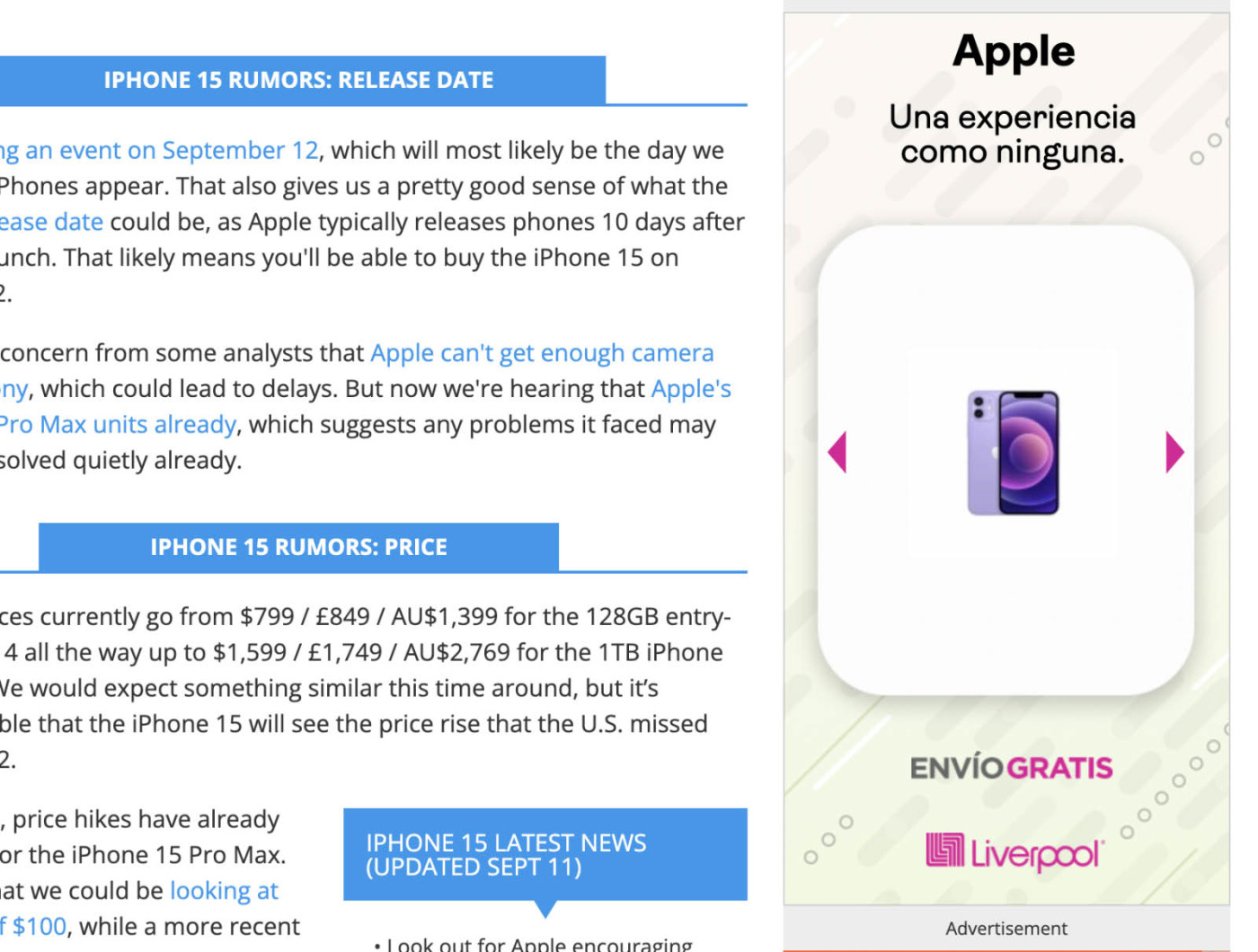
First, it knows where I am (Mexico), so it hits me with the right language. Second, it's timely and relevant. I was searching for some news about the upcoming iPhone 15 release, and it displayed an offer for Apple products (with free delivery!)
Type: Digital
When to use: If you're launching a new product, digital ads will get you quick eyeballs and clicks.
Cost: Moderate to high; pay-per-click costs can add up fast.
6. Video marketing
In the world of video marketing, your brand isn't just colors and text—it's movement, emotion, and sound. It's about weaving a narrative that resonates. You can showcase your product in action, dive deep into a customer testimonial, or go behind the scenes to reveal the real people behind your brand.
Let's face it. Apple's just really good at what they do.
Let's forget for a second that these ski goggles cost $3,500 and focus on how cool the actual tech seems. It's a product video that showcases exactly what the product is, how it works, and why it matters. And it's something that would be impossible to convey with the same impact using text or image alone.
Type: Digital
When to use: When a picture just won't cut it, go video; perfect for demos and emotional stories.
Cost: Moderate to high; quality video production can be expensive. If you're willing to go lo-fi, it can be a little less.
7. TV commercials
While commercials are technically videos, they serve a different purpose. TV ads are for when you're trying to get in front of a lot of people and get them talking.
Remember when literally everyone on the planet was saying "Wasuppppppppppp"? That's the power of a good TV commercial. They let your brand grab the mic and shout "wasssup" on one of the grandest stages. It's your shot at the kind of mass attention and memorability that digital channels often can't match. And if you're Coinbase, you don't even have to say anything.
Don't lie—you held your phone up to the screen, didn't you? Coinbase's Super Bowl ad was simple, nostalgic, and super effective.
Type: Traditional
When to use: If you have big news or you're going nationwide, TV's the spot for the big splash.
Cost: High; production and placement fees are some of the highest of all marketing channels.
8. Physical store
In an increasingly digital world, the tactile allure of a physical store is irreplaceable. This isn't just a place to display products—it's a fully immersive experience where customers can engage with your brand using all five senses. For businesses, this tangible touchpoint offers a unique opportunity to cultivate brand loyalty, conduct real-time customer research, and make immediate sales.
This is the Cartier storefront in Mexico City.

It highlights the brand's elegance, showcases its products, and feels welcoming enough to drop a few months' rent payments on a new watch.
Type: Traditional
When to use: If you've got products to display, consider opening up a shop. It's old school, in a good way.
Cost: High; includes rent, inventory, and staffing.
9. Billboards
Billboards are the showstoppers of the advertising realm. With their grand scale, they offer an unbeatable impact-to-viewer ratio. More than just ads, they're a way for brands to become part of the landscape, offering recurring visibility that imprints your message onto a broad audience. For businesses, billboards offer local dominance and are especially potent when combined with other media channels for a multi-touchpoint campaign.
There was an ad campaign a few years ago that had social media wondering if the streaming wars were spiraling out of control…

But it turns out, the supposed jab at Netflix…was Netflix itself. And the stunt was to promote a comedy festival in L.A. Did it work? Well, it's now the biggest comedy festival in the country.
Type: Traditional
When to use: Want to own a local area? Plant your message in the sky with a billboard.
Cost: Moderate to high; location and size determine the price.
10. Print ads
Print ads are the artisans of marketing. They invite readers to pause, consider, and engage at a leisurely pace that digital marketing rarely affords. What print ads lack in immediacy, they make up for in longevity and depth. Businesses that invest in print might find that their message lingers longer and with more gravity than those that flash briefly across a screen.
Take this Scrabble ad, for example.
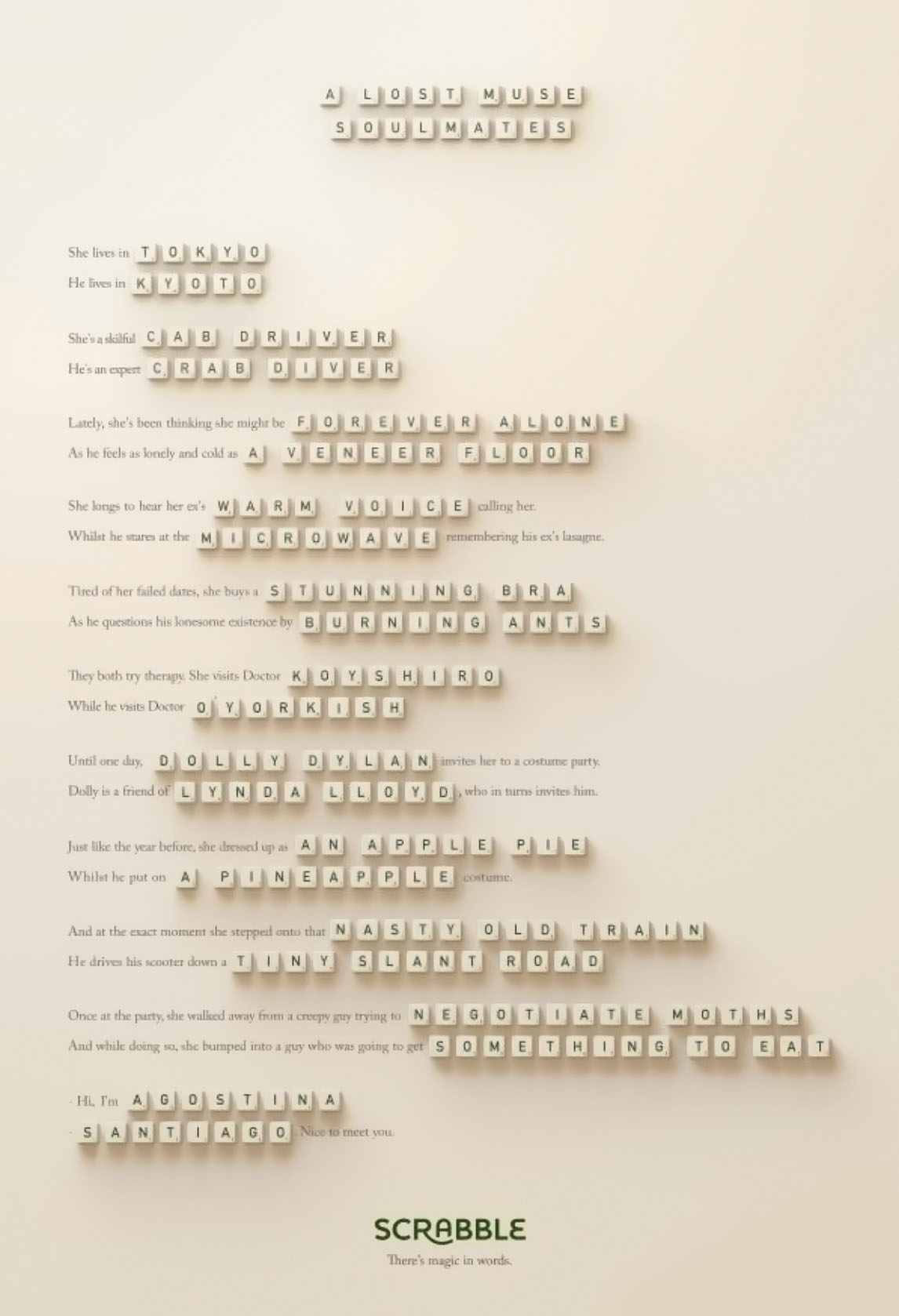
Lola Madrid absolutely knocked it out of the park with this print ad. It's visually stunning, it tells a story, and it's undeniably Scrabble.
Type: Traditional
When to use: Great for targeted, niche campaigns and products that benefit from longer consideration.
Cost: Moderate; costs vary depending on the publication and the complexity of the ad's design.
11. Direct mail
In the age of digital overload, there's something genuinely refreshing about receiving a physical piece of mail (assuming it's not something you tried to unsubscribe from three times already). Direct mail offers a unique opportunity to reach people at home and speak directly to them. It's tactile, it's personal, and it's enduring—unlike an email, a well-crafted piece of direct mail sticks around.
Here's a fun one from Kit Kat.
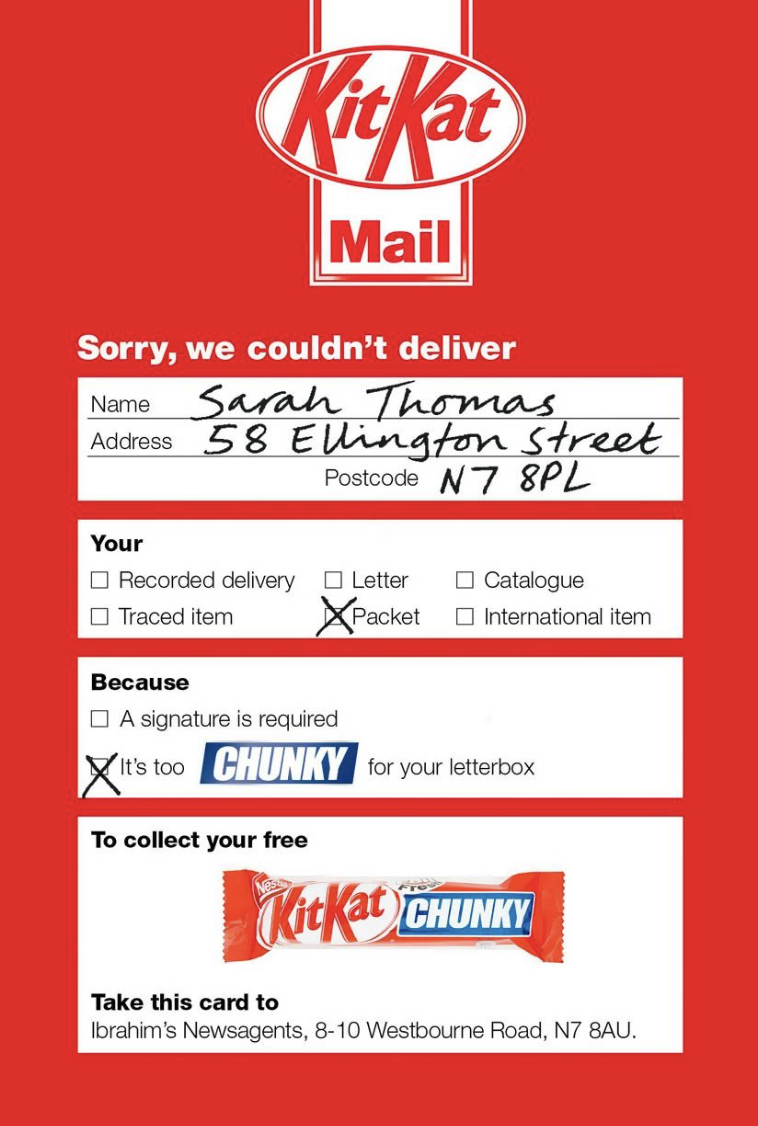
It captures Kit Kat's brand perfectly. And it's definitely something you'd show to your friends. It's bold, funny, and, apparently, too chunky for your mailbox.
Type: Direct
When to use: If you're looking to stick out among the digital overload, a snail mail campaign with a unique design might be for you. It also works well for local service-based businesses—people will be in their homes when they read about how you can help them make their home better.
Cost: Moderate; includes printing and postage.
12. Email
Imagine walking into a room and shaking hands with each of your customers. That's what a well-crafted email does. It's not just about spamming inboxes; it's about building a relationship. Email marketing gives you a direct line to your customers' inboxes, making it an ideal channel for personalized messages, tailored offers, and real-time updates.
Credit Karma has my number, for sure.
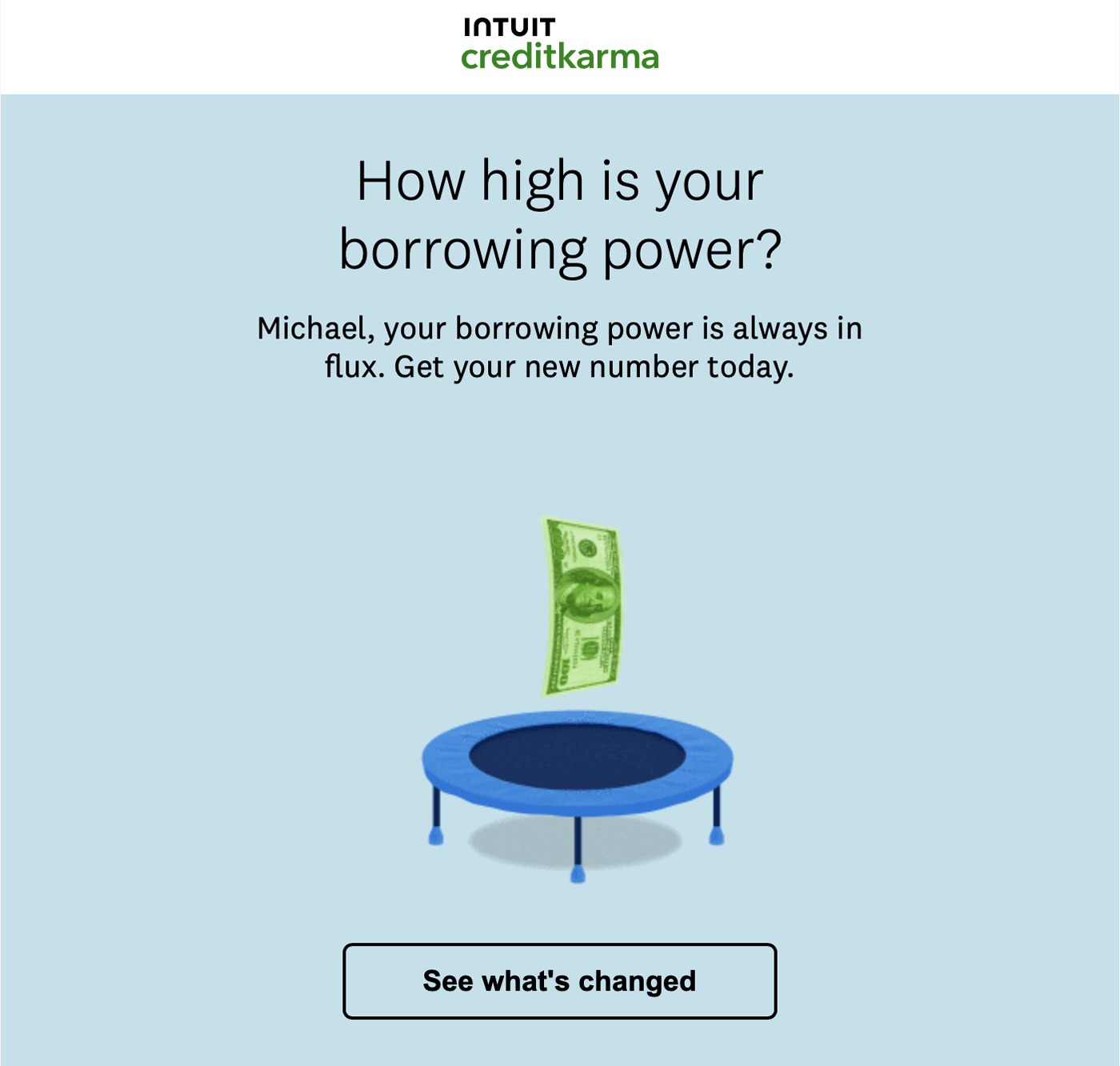
Why is this so good? First, the actual email shows a GIF of the dollar bill bouncing up and down. Second, I'm 30-something and I'm tied to the American financial system. This means I'm obsessed with my credit score, and Credit Karma knows it. So when they send me an email saying literally any number has changed, you know I'm going to check it.
Type: Direct
When to use: If you've got deals or news that can't wait, or you're looking to keep a relationship exciting with recurring newsletters, pop into their inbox.
Cost: Low; most costs are associated with email marketing software and possible content creation.
13. Sales team
The true power of a sales team lies not just in numbers but in relationship-building. A great salesperson understands the nuanced needs of each prospect and tailors the pitch accordingly. This is where the human touch proves invaluable, particularly for B2B or high-value, complex products where a quick video or blog post can't capture the whole story.
Remember the Kirby vacuum salespeople?

If you're unfamiliar with Kirby, let me tell you something that is almost certainly going to shock you. They've been selling vacuums door to door for over a century. Yes, 100 years. Why? They're expensive vacuums, so they need to show you exactly why they're worth the money. And it works.
Type: Direct
When to use: If you have a complex product, high-stakes deal, or are working with B2B enterprise customers, bring in the humans.
Cost: Moderate to high; includes salaries, commissions, and training.
14. Direct response marketing
Imagine if your advertising could not just catch eyes but also spur immediate action. That's direct response marketing for you. It's not just about brand awareness; it's about driving people to do something, right here, right now. It's the marketing equivalent of a limited-time offer that you can't refuse. With compelling CTAs and high-energy messaging, this form of advertising is the espresso shot of the marketing world.
Neil Patel does this well.
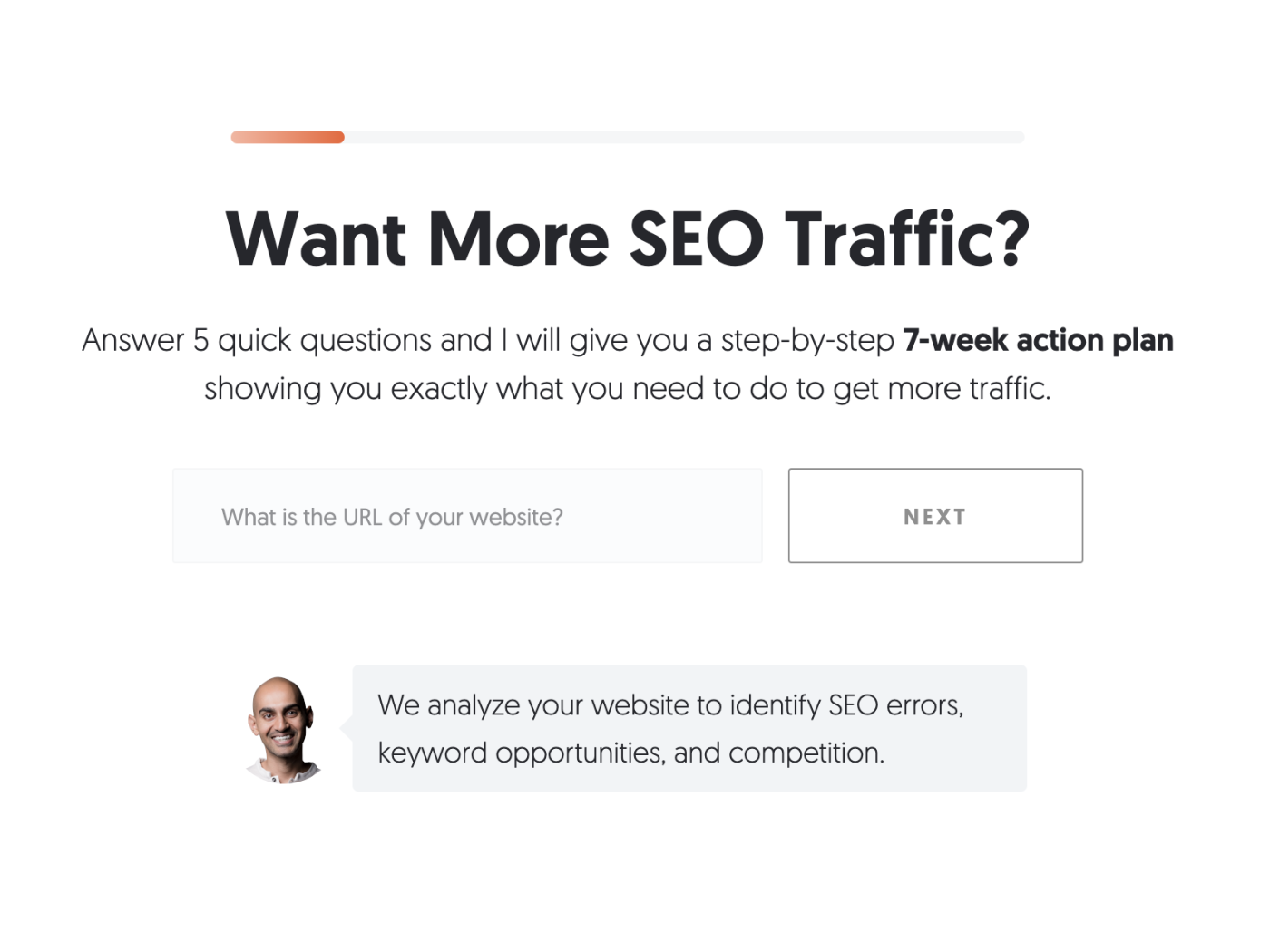
If you're on Mr. Patel's site, you definitely want more SEO traffic. If you follow the quick questionnaire above, it'll collect a bit of data and ultimately ask for your email in exchange for the seven-week action plan. An easy trade for a valuable resource, right?
Type: Direct
When to use: If you need a lot of leads, like, yesterday, direct response ads can help.
Cost: Moderate but platform-dependent; may require a higher ad spend for efficacy.
15. Events
You've shown your brand on-screen—now let customers experience it in the flesh. Events are the theater of the business world, where your brand is the star of the show. Whether it's a product launch, a conference, or an exclusive get-together, events offer a level of immersion and interactivity that no digital channel can replicate. It's where handshakes happen and deals are sealed.
Type: Indirect
When to use: If you're looking to build your network or launch a flagship product, events are a great stage for it. It's also a good way to show appreciation for your customers (especially if your event is free).
Cost: Moderate to high; venues aren't cheap, and you'll need staff and catering. If you want to dip your toes into events, you could try a virtual event instead, which will be lower cost.
16. Affiliate marketing
Think of affiliate marketing as your brand's extended family. A community of websites, bloggers, and influencers introduce your products to their audience, driving traffic to your site and increasing sales. The best part? You only pay for results, making it a low-risk, high-reward venture.
Amazon has one of the most intense affiliate programs out there.
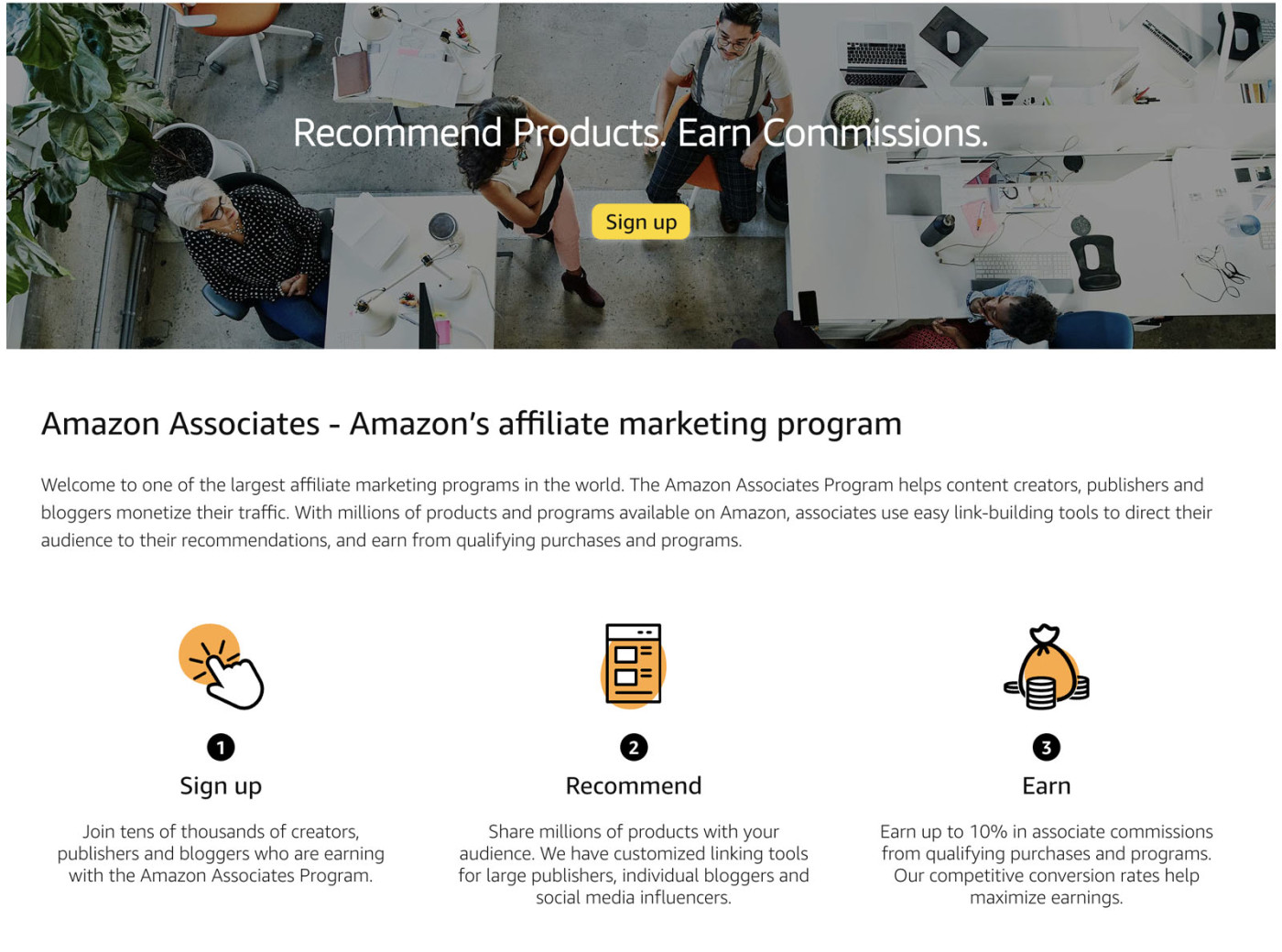
Its three-step-to-profit promise has created an army of sellers promoting Amazon products everywhere on the web. Publishers, content creators, dropshippers, and more dove into this opportunity headfirst for the chance at a quick buck by pushing Amazon products.
Type: Indirect
When to use: A trendy product that's perfect for social media can be an affiliate hit.
Cost: Low to moderate; you usually only pay for successful conversions.
17. Influencers
Influencers aren't just individuals; they're community leaders. They've built their platform on trust, credibility, and relatability, making them the ideal partners to bring your brand closer to your audience.
From fashionistas to food bloggers, the right influencer can inject your product into dialogues and spaces uniquely relevant to your industry. So, when an influencer says "jump," their followers don't just ask "how high"—they're already airborne. Here's an example.
@cookingwithlynja My @sweetgreen salad hack #1: The pretzels always stay on me! 🥨💚 #sweetgreenpartner ♬ original sound - Lynja
Lynja is an adored FoodTok personality, and some brands have taken notice. In this example, Lynja partnered with sweetgreen for a quick salad hack.
Type: Indirect
When to use: Engage influencers when you're looking to tap into established, trusting communities. They're perfect for humanizing your brand, reaching niche demographics, and sparking organic conversations around your product in spaces where traditional ads may fall flat.
Cost: Moderate to high; influencer fees vary greatly. If you're looking to get Cristiano Ronaldo to support a product, for example, you better have at least $2.4 mil on hand.
18. Joint ventures and partnerships
Think of a joint venture as a business marriage where two entities combine their resources, expertise, and customer bases for mutual success. But it's not just about reducing the costs or sharing the workload; it's about creating something new, innovative, and effective that neither could achieve alone.
Joint ventures are the embodiment of the old adage that two heads are better than one. They offer a shared risk and reward system that enables both brands to step out of their comfort zones and explore new avenues of growth and consumer engagement.
GoPro and Red Bull are a match made in adrenaline heaven.
In 2012, Red Bull sent Felix Baumgartner to space on a helium balloon with a parachute and a few GoPros. Needless to say, it got a lot of views. And it was a great promotion for GoPro's Hero 3.
Type: Indirect
When to use: If you have gaps in your product or service lineup, team up with a business that complements yours for a win-win. It can also be a great way to get a foot in the door with an adjacent audience.
Cost: Moderate; shared expenses but potentially high returns.
19. Word of mouth
Word of mouth is the lifeblood of organic growth and brand credibility. One person tells two friends, they tell four more, and so on—the network effect takes over, creating an ever-expanding circle of brand ambassadors. And unlike any other form of advertising, word of mouth comes with built-in trust.
Customer reviews are a modern manifestation of word of mouth. When potential buyers see real testimonials, be it on your site or third-party platforms, it bolsters their confidence in your product or service. Positive reviews act as endorsements, giving newcomers that much-needed nudge to make a purchase.
The impact of word of mouth goes beyond immediate conversions to foster long-lasting customer relationships. It's the marketing equivalent of a snowball rolling down a hill, gathering size and speed; all it takes is one little push to set it in motion, and the momentum takes care of the rest.
Type: Indirect
When to use: Always; happy customers are the best advertising a business can ask for.
Cost: Free
How to choose your marketing channels
You don't need to be everywhere; you just need to be where it counts. Here's how to fish where the fish are:
Understand your audience: Knowing your target customer is key. Conduct market research to collect data on demographics and behaviors. Use this information to create audience personas, helping you tailor your marketing strategies to resonate with those who actually care about what you're offering.
Analyze your resources: Take a hard look at what you've got—be it cash, time, or coding skills. Are your pockets deep but time is tight? Maybe automated digital ads are the way to go. Or do you have coding skills but limited cash? Then optimizing your website for SEO could be your best bet. Knowing your resources keeps you realistic and prevents you from overreaching.
Determine your goals: What's the win for you? More clicks, more bricks, or more buzz? Pinpoint your endgame and let that clarity drive your choice of marketing channels. Align these goals with specific KPIs to keep yourself accountable.
Test and measure: Launch, learn, tweak, repeat. Marketing is an iterative process. Launch campaigns, gather data using analytics tools, then refine your approach based on what's working. A robust data-driven cycle lets you optimize for the channels that genuinely engage your audience.
Consider integration: Don't let your marketing channels operate on deserted islands. Aim for brand consistency and message alignment across platforms. Use tools that offer integration features, like Zapier, to seamlessly connect all your marketing channels, achieving a true omnichannel experience.
Stay updated: New platforms pop up, algorithms change, and attention spans drift. Stay on your toes and monitor the competition because the marketing world doesn't stand still.
How many channels should you focus on?
This is often the million-dollar question. While there's no one-size-fits-all answer, a good rule for small to medium-sized businesses is to start with 2-3 channels and optimize. As you become more comfortable and your campaigns begin to pay off, consider gradually incorporating more channels.
Here's an example of a hypothetical channel distribution for a sneaker brand.
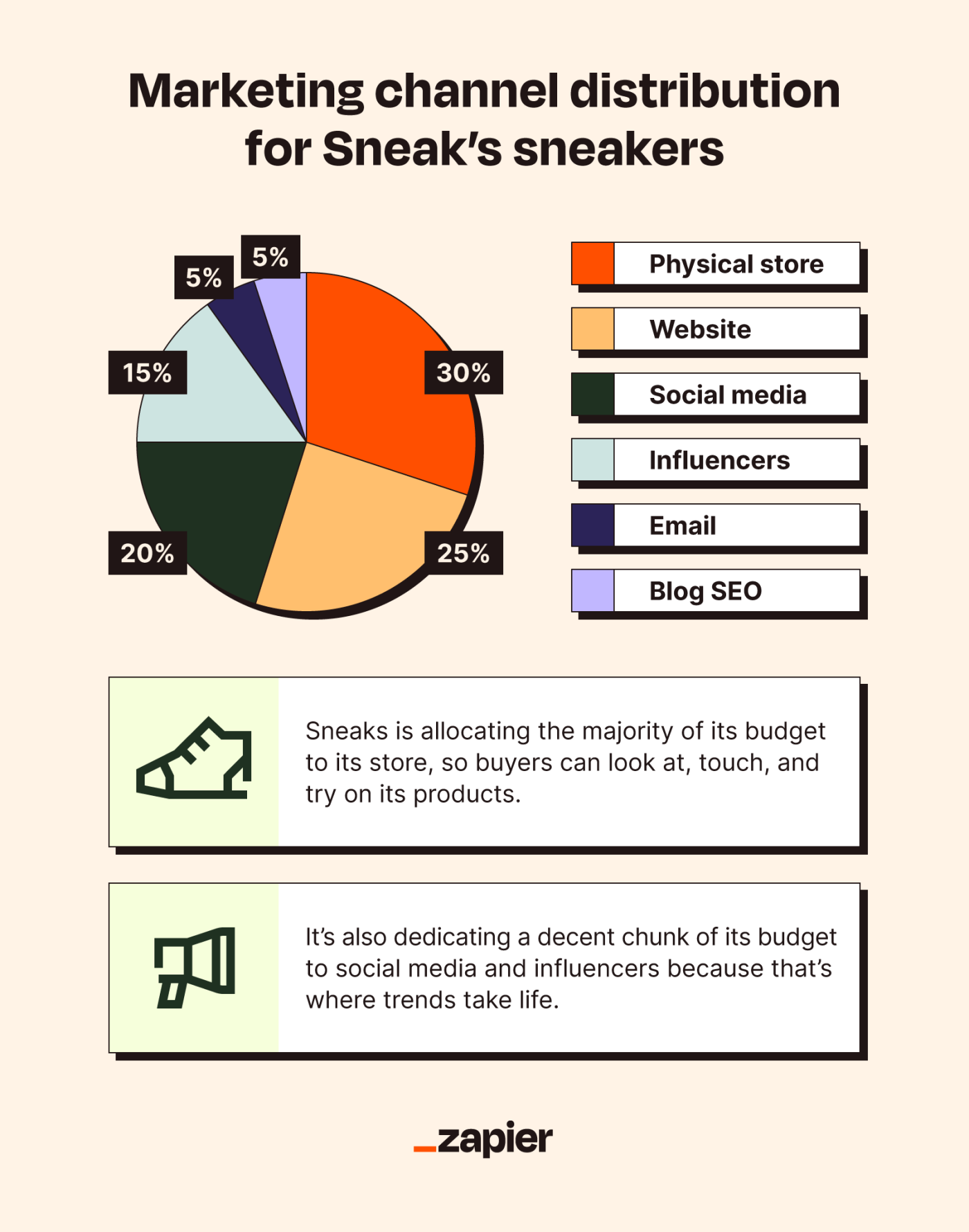
Marketing channels FAQ
Curious to dig a little deeper? Here's a synopsis based on some frequently asked questions.
What are marketing channel examples?
Think banner ads, websites, email marketing, and even good ol' billboards on the highway. These are various ways you get your brand message across to your audience. We've outlined 19 different channels here, so scroll up for more.
Why do companies use marketing channels?
It's all about getting the word out and ringing the cash register. Different channels reach different people and accomplish different goals—be it building awareness, driving sales, or fostering loyalty.
Is social media a marketing channel?
You bet. Social media is like the virtual water cooler where you get to chit chat with your audience. It's great for relationship-building, customer service, and yes, even making those sales.
Get the most out of your marketing channels
There are a lot of marketing channels to choose from, but when you find the ones that work for you and your brand, make sure to eliminate the manual slog that might come with setup. By automating your marketing operations and processes, you're not working harder; you're working smarter. This will allow you to focus on the fun stuff like creating the next "wassup"—or training your vacuum sales team.
Related reading:
